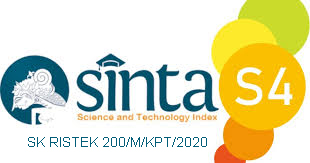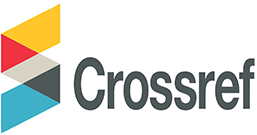Features Selection based on Enhanced KNN to Predict Raw Material Needs on PT. SANM
Abstract
Keywords
Full Text:
PDFReferences
R. Arian, A. Hariri, A. Mehridehnavi, A. Fassihi, and F. Ghasemi, “Protein kinase inhibitors’ classification using K-Nearest neighbor algorithm,” Comput. Biol. Chem., vol. 86, no. April, p. 107269, 2020, doi: 10.1016/j.compbiolchem.2020.107269.
F. Borghesan, M. Chioua, and N. F. Thornhill, “Forecasting of process disturbances using k-nearest neighbours, with an application in process control,” Comput. Chem. Eng., vol. 128, no. 675215, pp. 188–200, 2019, doi: 10.1016/j.compchemeng.2019.05.009.
D. A. Adeniyi, Z. Wei, and Y. Yongquan, “Automated web usage data mining and recommendation system using K-Nearest Neighbor (KNN) classification method,” Appl. Comput. Informatics, vol. 12, no. 1, pp. 90–108, 2016, doi: 10.1016/j.aci.2014.10.001.
W. M. Shaban, A. H. Rabie, A. I. Saleh, and M. A. Abo-Elsoud, “A new COVID-19 Patients Detection Strategy (CPDS) based on hybrid feature selection and enhanced KNN classifier,” Knowledge-Based Syst., vol. 205, p. 106270, 2020, doi: 10.1016/j.knosys.2020.106270.
M. A. Oktaviani, R. S. Wibowo, and N. K. Aryani, “Aliran Daya Optimal dengan Efek Katup Menggunakan Grey Wolf Optimization,” J. Tek. ITS, vol. 7, no. 2, 2019, doi: 10.12962/j23373539.v7i2.30906.
S. Mirjalili, S. M. Mirjalili, and A. Lewis, “Grey Wolf Optimizer,” Adv. Eng. Softw., vol. 69, pp. 46–61, 2014, doi: 10.1016/j.advengsoft.2013.12.007.
M. H. Nadimi-Shahraki, S. Taghian, and S. Mirjalili, “An improved grey wolf optimizer for solving engineering problems,” Expert Syst. Appl., vol. 166, p. 113917, 2021, doi: 10.1016/j.eswa.2020.113917.
J. Gholami, F. Pourpanah, and X. Wang, “Feature selection based on improved binary global harmony search for data classification,” Appl. Soft Comput. J., vol. 93, p. 106402, 2020, doi: 10.1016/j.asoc.2020.106402.
R. D. Liklikwatil, E. Noersasongko, and C. Supriyanto, “Optimasi K-Nearest Neighbor Dengan Particle Swarm Optimization Untuk Memprediksi Harga Komoditi Karet,” e-Jurnal JUSITI (Jurnal Sist. Inf. dan Teknol. Informasi), vol. 7–2, no. 2, pp. 172–182, 2018, doi: 10.36774/jusiti.v7i2.252.
N. Bharanidharan and H. Rajaguru, “Classification of dementia using harmony search optimization technique,” IEEE Reg. 10 Humanit. Technol. Conf. R10-HTC, vol. 2018-Decem, pp. 1–5, 2019, doi: 10.1109/R10-HTC.2018.8629846.
L. S. Han and J. A. N. Nordin, “Predicting the stock price trends using a K-nearest neighbors-probabilistic model,” J. Theor. Appl. Inf. Technol., vol. 96, no. 18, pp. 6245–6255, 2018.
M. E. Lasulika, “Prediksi Harga Komoditi Jagung Menggunakan K-Nn Dan Particle Swarm Optimazation Sebagai Fitur Seleksi,” Ilk. J. Ilm., vol. 9, no. 3, pp. 233–238, 2017, doi: 10.33096/ilkom.v9i3.148.233-238.
B. Song, S. Tan, H. Shi, and B. Zhao, “Fault detection and diagnosis via standardized k nearest neighbor for multimode process,” J. Taiwan Inst. Chem. Eng., vol. 106, no. xxxx, pp. 1–8, 2020, doi: 10.1016/j.jtice.2019.09.017.
A. Sharma, P. Madhushri, V. Kushvaha, and A. Kumar, “Prediction of the Fracture Toughness of Silicafilled Epoxy Composites using K-Nearest Neighbor (KNN) Method,” 2020 Int. Conf. Comput. Perform. Eval. ComPE 2020, pp. 194–198, 2020, doi: 10.1109/ComPE49325.2020.9200093.
M. Bramer, Principles of Data Mining. Springer London, 2007.
DOI: https://doi.org/10.31326/jisa.v4i2.912
Refbacks
- There are currently no refbacks.
Copyright (c) 2021 Siti Aisyah Naili Mutia,Tjong Wan Sen

This work is licensed under a Creative Commons Attribution-ShareAlike 4.0 International License.
JOURNAL IDENTITY
Journal Name: JISA (Jurnal Informatika dan Sains)
e-ISSN: 2614-8404, p-ISSN: 2776-3234
Publisher: Program Studi Teknik Informatika Universitas Trilogi
Publication Schedule: June and December
Language: English
APC: The Journal Charges Fees for Publishing
Indexing: EBSCO , DOAJ, Google Scholar, Arsip Relawan Jurnal Indonesia, Directory of Research Journals Indexing, Index Copernicus International, PKP Index, Science and Technology Index (SINTA, S4) , Garuda Index
OAI address: http://trilogi.ac.id/journal/ks/index.php/JISA/oai
Contact: jisa@trilogi.ac.id
Sponsored by: DOI – Digital Object Identifier Crossref, Universitas Trilogi
In Collaboration With: Indonesian Artificial Intelligent Ecosystem(IAIE), Relawan Jurnal Indonesia, Jurnal Teknologi dan Sistem Komputer (JTSiskom)
JISA (Jurnal Informatika dan Sains) is Published by Program Studi Teknik Informatika, Universitas Trilogi under Creative Commons Attribution-ShareAlike 4.0 International License.


















